

3 methods for boxing corners on bags. Take a look at some of the bags you own.
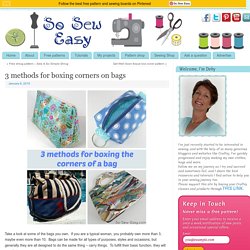
If you are a typical woman, you probably own more than 3, maybe even more than 10. Bags can be made for all types of purposes, styles and occasions, but generally they are all designed to do the same thing – carry things. To fulfill their basic function, they will usually have common features such as straps or handles, zips or closures, and pockets. They can be flat like a simple tote bag designed to carry a few light items and perhaps roll or fold up flat, or can be designed where their size and shape fit a certain function, such as the Easy Cosmetics Bag you see here.
One common feature that most bags will have is some kind of volume. The volume at the bottom in a bag with boxed corners can be created 3 different ways. Sew the perfect slip pocket for your bag. I’m taking the Design Your Own Handbag Class on Craftsy at the moment and am picking up lots of tips about how to sew bags as well as how to design them.
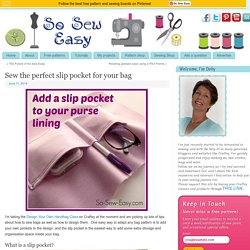
One easy way to adapt any bag pattern is to add your own pockets to the design, and the slip pocket is the easiest way to add some extra storage and organisation space inside your bag. What is a slip pocket? A slip pocket is a basic open pocket, usually on the inside of a bag, where you can simply ‘slip’ something in easily. It has no buttons, zips or closures and is the easiest pocket to sew.
It will be sewn onto the lining piece before the bag lining is assembled. What makes the perfect slip pocket. How to sew a recessed zipper on a bag. I’ve been working on some new bag ideas and one of the areas of bag-making that has been a bit of a puzzle to me until recently is how to close the top of the bag.
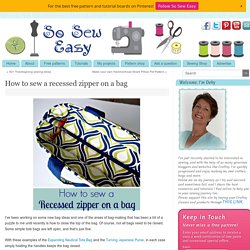
Of course, not all bags need to be closed. Some simple tote bags are left open, and that’s just fine. With these examples of the Expanding Nautical Tote Bag and the Turning Japanese Purse, in each case simply holding the handles keeps the bag closed. The Zipper Top Tote bag as a zipper right across the top and isn’t very deep. Other bags I’ve made have either had magnetic closures and snaps or zippers at the top, like the Easy Cosmetics Bag. You can pretty much add this to the top of any bag which has a lining, so even if the pattern doesn’t call for it, you can split the lining and add in the recessed zipper. How to install bag feet - 2 styles. I’m always looking for ways to make my homemade bags looks more professional and although it does increase the cost, adding hardware such as clasps, feet, grommets, sliders, straps, rivets, studs and handles really does make them look great.
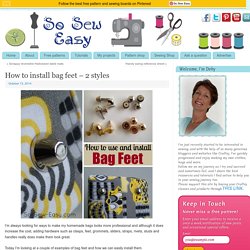
Today I’m looking at a couple of examples of bag feet and how we can easily install them. Both of these examples came from Pacific Trimming. There is one you are probably more familiar with, the flattened cone shaped ones with the long prongs, and another that you don’t see as often but are actually very versatile, these dome shaped ones with a screw fitting. Let’s have a look at how we can use them. How to install Bag Feet – Do you have a ‘firm bottom’ ? Firstly, in order to install the bag feet, you need a bag with something in the bottom other than just fabric. What you use depends either on what is called for in the pattern, or just what you can get locally. Options: How To Sew An Inner Zipper Pocket. I have tried several ways to sew in internal zipper pockets.
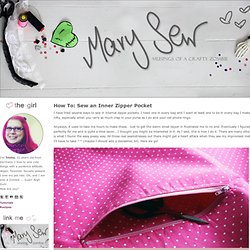
I need one in every bag and I want at least one to be in every bag I make for my shop. They are so nifty, especially when you carry as much crap in your purse as I do and your cell phone rings. Anyways, it used to take me hours to make these. Just to get the damn small zipper in frustrated me to no end. Fusible Interfacing. More about interfacing: Woven vs.
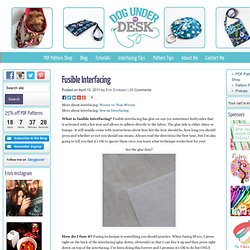
Non-Woven More about interfacing: Sew-in Interfacing What is fusible interfacing? Fusible interfacing has glue on one (or sometimes both) sides that is activated with a hot iron and allows to adhere directly to the fabric. The glue side is either shiny or bumpy. It will usually come with instructions about how hot the iron should be, how long you should press and whether or not you should use steam. See the glue dots? How do I fuse it? Why use fusible interfacing? I use fusible interfacing on almost every project, usually inside and out. If I need more thickness than just two layers of fusible (outside and lining) I will typically add batting, fleece or sew-in interfacing.
Which interfacing should I choose? Common Types of Fusible interfacing Non-woven fusible interfacing – This is the paper kind of interfacing, rather than the fabric (woven) kind. How To Sew A Circular Bottom Neatly. Round bottom is a nice feature not only for bag bottom but also for a cylindrical pouches and bags. Here is how! Step 1. Make a card board template for a half circle. Make sure that you do this very neatly. Fold the fabric in half, secure it with pins. Step 2. Step 3. ! Useful Techniques For Bag Making.
Adding A Hard Bottom To Your Bags.